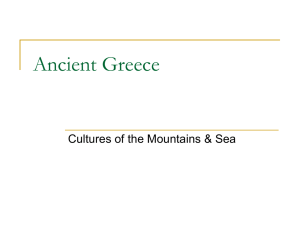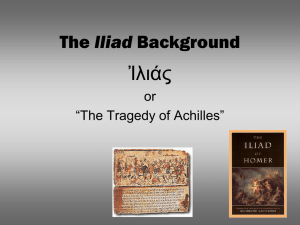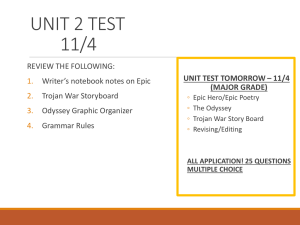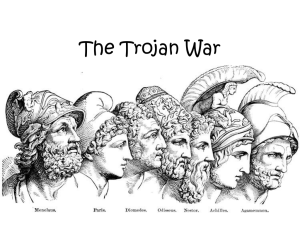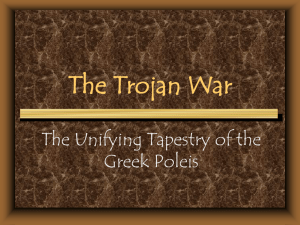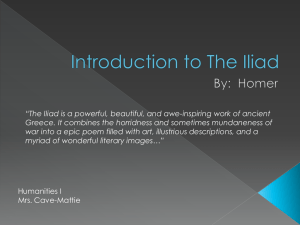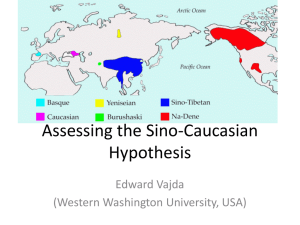File - Oak Hill Academy Latin
advertisement
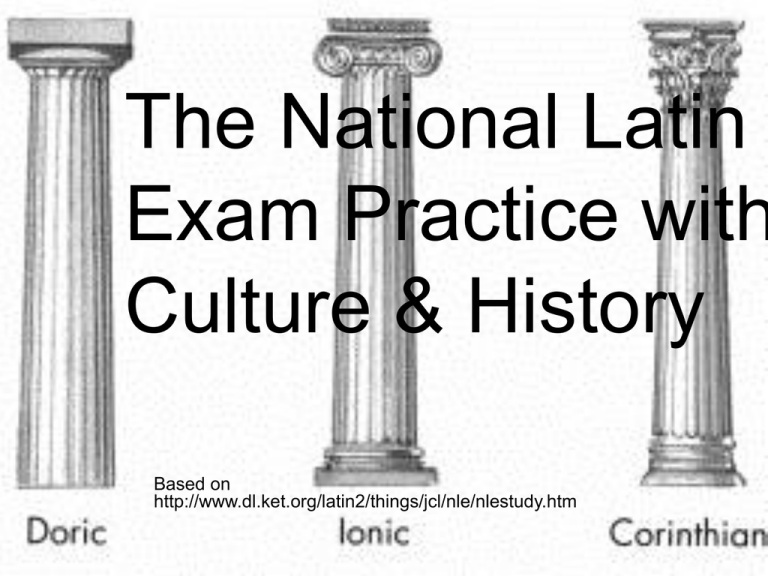
The National Latin Exam Practice with Culture & History Based on http://www.dl.ket.org/latin2/things/jcl/nle/nlestudy.htm The National Latin Exam, which is taken annually by over 100, 000 students from all over the world tests students knowledge of 3 main areas: •Grammar : Forms and Syntax •Culture and Civilization •Latin in Use (Today) Geography Tiber River Apennines Ostia Pompeii Vesuvius Brundisium Sicily Corsica Sardina Capitoline Palatine Appian Way Gibraltar Carthage Mare Nostrum Orbis Terrarum Latium Etruscans Troy Rubicon Names nomen praenomen People Buildings cognomen Romulus Forum ientaculum Lares/Penates Remus Curia (senate prandium Lararium Rhea house) cena Silvia/Mars Basilica (law court) genius/juno Columns pontifex maximus Cincinnatus rostra (speaker's lonian haruspex Horatius platform) Doric augur Scipio Circus Maximus Corinthian Housing Hannibal Pantheon Clothing Domus Gaius lulius Parthenon toga virilis Insulae (apartment) Caesar Acropolis toga praetexta Villa, rustica & Spartacus urbana toga candida Colosseum Augustus Campus Martius Taberna (shops) stola Cicero Cloaca Maxima Atrium palla arch Impluvium tunica Authors dome Compluvium bulla Tablinum Homer aqueduct soleae Ovid Thermae, Balnei Cubiculum Religion Culina Vergil caldarium polytheism triclinium Livy (historian) Olympians tepidarium peristilium frigidarium nectar ianua ambrosia janitor Things to Review Meals School ludus paedagogus - the slave that brings kids to/from school stilus tabellae – writing tablets magister – teacher grammaticus Ouotes/Mottos Veni, vidi, vici Carpe diem E pluribus unum Novus ordor saeclorurn Annuit Coeptis Sic semper tyrannis Panem et circenses Mens sana in corpore sano SPQR Nota Bene Names nomen = name of clan praenomen = 1st name cognomen = official nickname Lares/Penates = household gods Lararium = shrine for the household gods genius = birth spirit, one’s nature pontifex maximus = high priest haruspex = priest who reads livers augur = priest who examines the flight pattern of birds Housing domus = home insulae = apartment building villa rustica = country villa or estate villa urbana = city villa tabernae = shops // ianua = door // ianitor = doorman atrium = main entrance hall impluvium = pool in atrium for collecting rainwater compluvium = opening above the impluvium tablinum = study, den cubiculum = bedroom culina = kitchen triclinium =diningroom Let’s work backwards and start with Part III: Latin in Use Basic spoken phrases, such as… • Salvē! & Salvēte! = Hello! (think Salutations!) • Valē! & Salvēte! = Goodbye! (think valedictorian) • Quid est nomen tibi? = What is your name? • Mihi nomen est Rufus. = My name is Rufus. • Adsum! = “I am here.” • Quid agis? = How are you? •Quota hora est? = What time is it? • Quid novi? = What’s new? [nihil novi = nothing new] • Gratias tibi ago! = Thank you! • Ita! = Yes [Ita vero = yes!] • Minime! = No! • Quaenam tempestas est? = What is the weather? Latin in Use Derivatives (or words that come from Latin): for example… • ambulatory (from ambulâre = to walk) • fraternity (from frater = brother) • arboreal (from arbor = tree) • maritime (from mare = sea) • consider (from sidus, sideris = star) • aquatic (from aqua = water) • lunatic (from luna = moon) • solar (from sol = sun) • nomenclature or nominate (from nomen = name) • temporary or contemporary (from tempus, temporis = time) Latin in Use Expressions, Mottoes, and Abbreviations in common use; e.g., •semper fidelis = always faithful •semper paratus = always prepared •tempus fugit = time flies •anno domini = in the year of the Lord •N.B. or Nota Bene = "make careful note of" •stat = “immediately” you can find a list of common abbreviations here and mottoes on the subsequent pages: ABBRVIATION S.P.Q.R. P.S. sc./scii. R.I.P. M.A. P.M. p.m. i.e. A.D. e.g. B.I.D. etc. Q.E.D. N.B. cf. Ph.D. a.m. id. M C LATIN MEANING ENGLISH MEANING Senatus Poplusque Romanus The Senate and the Roman People Post Scriptum scilicet (scire licet) Requiescat in Pace Magister Artium Post Mortem post meridiem id est Anno Domini exempli gratia Bis in Die et cetera Quod Erat Demonstrandum Written Afterwards actually May he/she rest in peace Master of Arts After Death afternoon that is (= in other words) In the year of the Lord for example Twice a Day and the rest Which was to be demonstrated Nota Bene confer Philosophiae Doctor ante meridiem idem Mille Centium Note Well compare Doctor of Philosophy before noon the same a thousand a hundred Mottoes and Quotations (PAGE 1) 1.Ad nauseam = To the point of disgust 2.Annuit Coeptis = He has approved of what has been begun. •Ars Gratia Artis = Art for the sake of art •Cave canem = Beware the dog. •Caveat Emptor = Let the buyer beware. •Cogito ergo sum = I think. therefore I am. (Descartes) •Corpus delicti = The body of the crime •Dextro pede = Enter with your right foot first. (a good luck sign) •E Pluribus Unum = One from many (MOTTO OF THE USA!!!) •Habeas corpus (ad subiciendum) = You may allow the prisoner (to be handed over for pre-trial determination). Mottoes and Quotations (PAGE 2) 1.Nolo contendere = I don't want to contest the charges (and I accept the penalty without admitting guilt). 2.Pax vobiscum /Pax tecum = Peace be with you. •Pro bono = Something done out of good will with no charge •Possunt quia posse videntur = They can because they think they can. •Quasi modo geniti Infantes = Just like new born babes" (Opening words of the Introit (1 Pet. 2.2.) used on the first Sunday after Easter; This sunday was called "Quasi Modo" Sunday.) •Rara avis = A rare bird •Semper fidelis = Always faithful (U.S. Marine Corps) •Sic transit gloria mundi = Thus passes the glory of the world •Tempus fugit = Time files. •Terra Firma = Solid ground •Veni, vidi, vici = I came, I saw, I conquered. (Julius Caesar vs King of Pontus) Courtesy of "Study Sheets for Latin Cultural Drill Tapes," by Dr. B.F. Barcio, L.H.D. Pompeiiana, Inc. Indianapolis, IN Medical Terminology derived from Latin (there’s a lot; here is a cross section) abdomen, adipose, adrenal, adventitia, afferent (used for a variety of structures carrying material or impulses to a center or to an organ), ala (a wing), alimentary, alveolus, ampulla, annulus, antero-, antrum, apical , appendix , aqueduct, areola , articulation, atrium, auditory, auricle, axial , bicuspid, bile, brachial, brevis, buccal, bulla, bursa, cadaver, calcaneus, capillary, caput, caput medusae, carina, cartilage, cauda, cava, cecum, cell, cerebellum, cerebrum, cervical, cervix, cilia, ciliary, circulation, cisterna, clavicle, conjunctiva, conjunctivitis, constriction, cornea, coronary, corpus, corpse, cortex, cibriform, crus, a few Legal Latin phrases still in use in today’s courts: Habeas corpus In absentia In loco parentis Aut dedere aut judicare Bona fide / Mala fides Ipso facto Ex post facto Mandamus Mens rea Mutatis mutandis Nolo contendere Obiter dictum Persona non grata Non compos mentis Quid pro quo Ultra vires Pro bono II. Culture and Civilization A. Geography Locate Roman provinces and important foreign cities, such as Aegyptus; Alexandria; Athens; Asia Minor; Britannia; Carthage; Gallia; Germania; Graecia; Hispania; Troy; - start with the maps on pp. xiii and xv of Ecce Romani. Here's a list of important places: [http://www.dl.ket.org/latin1/things/jcl/nle/geography.htm] Important features of Italy, such as major cities (Ostia, Pompeii, Brundisium), seas and rivers (Mare Nostrum, Adriatic Sea, Aegean Sea, Black Sea, Rhine), large islands (e.g. Sicilia, Creta), the Appennine mountains, Mt. Vesuvius, and so on. If you feel up to a real test, try this geography quiz! [http://www.dl.ket.org/latin2/historia/maps/romemapquiz/mp20.htm] Geography • Be able to identify the following on a map: •Roma, Italia, Graecia, Britannia, Hispania, Mare Nostrum, Tiber River Hispania Roma Graecia Mare Nostrum http://www.worldhistory.timemaps.com/images/200BC/RomanRepublic.jpg Britannia The Tiber River runs through the city of Rome http://wps.ablongman.com/wps/media/objects/262/268312/art/figures/KISH077.jpg The Seven Hills of Rome and the Tiber River List of important places: o Adriatic- Sea east of Italy o Aetna- Live volcano on the island of Sicily (Sicilia) o Alps- Mountain range dividing France (Gallia-Transalpina) from Northern Italy (Gallia Cisalpina) o Apennines- Mountain range forming the spine of the Italian peninsula (Italia) o Athens- Cultural capital of ancient Greece (Graecia); location of the Acropolis & Athena's Parthenon o Brundisium- Town which marked the southern end of the Appian Way on the heel of Italy o Capua- Town south of Rome famous for Its amphitheater and gladiator training school o o Corsica- Northern-most large island In theTyrrhenian Sea west of Italy o Crete- Island (Creta) located south of Greece; its capital, Knossos, was home to the Minotaur o Delos- Aegean Island on which Apollo and Diana were born near Mt. Cynthus o Delphi - sanctuary sacred to Apollo in northern Greece; home of the Delphic Oracle o Herculaneum- Town located west Of Mt. Vesuvius; buried by Mountain volcanic mud in A.D. 79 o Mare Nostrum- Roman name for the Mediterranean Sea; literally “our sea” o Mycenae- Home town of Agamemnon in southern Greece (the Peloponnesus) o Olympia- Sanctuary sacred to Zeus in southern Greece; site of the early Greek Olympic games o Olympus- - Mountain in northern Greece (Graecia) said to be the home of the gods o Ostia- Town which became the main poet of Rome at the mouth of the Tiber River o Pompeii- Town located south of Mt. Vesuvius; buried by volcanic ash in AD. 79 o Pyrenees- Mountain range dividing France (Gallia Transalpina) from Spain oRubicon- Small stream which originally divided Gallia Cisalpina from Italy o Sardinia- Southern-most large island in the Tyrrhenian Sea west of Italy o Sicily- Island (Sicilia) off the toe of Italy; Rome's first province o Sparta- Home town of Menelaus and his kidnapped wife Helen in southern Greece (Peloponnesus) o Stabiae- Wealthy resort area on the southern shore of the Bay of Naples; destroyed In A.D. 79 o Tiber- River on which Rome is located on the west coast of Italy o Troy- Ancient town located south-west of Istanbul in Turkey (Asia Minor) o Tyrrhenian- Sea west of Italy o Underworld- Ruled by Roman Pluto/Greek Hades: Tartarus = Hell; o Elysian Fields = Heaven : the best section of Hades o Vesuvius- Live volcano which buried Pompeii, Herculaneum and Stabiae near the Bay of Naples o Via Appia-"Queen of the Roman Roads" which led southeast from Rome to Capua and Brundisium B. History basic terms and general information associated with these topics: [http://www.dl.ket.org/latin1/things/jcl/nle/historic.htm] Monarchy - know the 7 kings of Rome (Ecce Romani Book I pp. 109-11) and see this early history of Rome and a table of her seven kings. You can consult the timeline at the back of Ecce Romani but there is one misprint: the first king of Rome is Romulus, of course, not Aeneas! [http://www.dl.ket.org/latin2/historia/monarchy/monarchy.htm] Heroes of early Rome (Ecce Romani Book I pp. 141-3) Prominent historical characters from Roman history: Augustus, Hannibal, Julius Caesar, Cleopatra, Marc Antony, Spartacus, Horatius, Cincinnatus [http://www.dl.ket.org/latin1/things/jcl/nle/history.htm] Major events of Roman History: Punic Wars, Caesar's conquest of Gaul Republic - 2 co-equal consuls elected annually Empire - emperor Cursus honorum (Ecce Romani Book I pp. 168-9) [http://www.dl.ket.org/latin1/things/jcl/nle/magistrates.htm] Important: check out this page of general vocabulary words that Ecce Romani skims over. [http://www.dl.ket.org/latin1/things/jcl/nle/nle-vocab.htm] 753-510 B.C.-THE MONARCHY Romulus and Remus The Seven Kings •Romulus • Numa Pompilius •Tullius Hostilius •Ancus Marcus (or Ancus Martius) •Tarquinius Priscus •Servius Tullius •Tarquinius Superbus (“Tarquin the Proud”) L. Junius Brutus Horatius Cocles Mucius Scaevola Courtesy of "Study Sheets for Latin Cultural Drill Tapes," by Dr. B.F. Barcio, L.H.D. Pompeiiana, Inc. Indianapolis, IN 510-31 B.C. - THE REPUBLIC… SPQR oThe Plebeian Struggle (vs. Patricians) oCoriolanus oThe Gauls Sack Rome oMarcus Manlius Capitolinus oAppius Claudius Caecus oThe Punic Wars oRegulus oHannibal oScipio Africanus (the Elder) oCato the Censor oOverseas Expansion and Trade oThe Gracchi Brothers oThe Civil Wars oSpartacus oPompey oJulius Caesar oCicero oCleopatra oMark Antony Courtesy of "Study Sheets for Latin Cultural Drill Tapes," by Dr. B.F. Barcio, L.H.D. Pompeiiana, Inc. Indianapolis, IN 31 B.C.- 476 A.D.-THE EMPIRE •The Battle of Actium and Augustus •The Pax Romana •Vergil •Martial •Boudicca •Tacitus •The Romanization of the Provinces •Caligula •Claudius •Nero •Trajan •Hadrian •Marcus Aurelius •Constantine •The Empire Splits •The Decline and Fall Courtesy of "Study Sheets for Latin Cultural Drill Tapes," by Dr. B.F. Barcio, L.H.D. Pompeiiana, Inc. Indianapolis, IN Here is another 0utline of Roman History (Mr. J. Rockey 1/08) LEGENDS leading up to the founding of Rome (c. 1400 - 753 b.c.) Minoan culture dominates Crete palace culture; Knossos; thalassocracy; King Minos and labyrinth Mycenaean period hill fortress towns: Mycenae, Argos, Phocis, Thebes, Tiryns; Trojan War c. 1200 b.c. “Dorian Invasion” & “Dark Age” last wave of Indo-European invaders from the north to settle in Greek lands; general decline in culture and standard of living Emergence of Literacy Homer Iliad and Odyssey; Aeneas flees Troy; Hesiod Theogony, Works and Days Legends of Rome’s prehistory Aeneas comes to Latium; Turnus and Lavinia; Lavinium; Ascanius/Iulus founds Alba Longa; Alban Monarchy; Numitor, Amulius, Rhea Silvia and Mars; Romulus and Remus; Tiber; she-wolf; Faustulus; vultures; Palatine Hill MONARCHY (753 – 509 b.c.) – There Were 7 Kings of Rome 1. Romulus… shepherd-bandit-warlord-king; Sabine women; “Quirinus” = the deified Romulus 2. Numa Pompilius… pious Sabine confers w/nymph Egeria re traditions and religious law; founds most Roman institutions and priesthoods; calendar 3. Tullus Hostilius …sacks Alba Longa 4. Ancus Marcius… founds seaport town of Ostia 5. Tarquinius Priscus… Lucumo, Greek refugee’s son from Etruria; marries noble Etruscan woman Tanaquil; augury; assassinated by Ancus’ sons 6. Servius Tullius… slave boy; flame omen; built first network of defensive walls; daughter Tullia marries predecessor’s son Lucius 7. Tarquinius Superbus… arrogant usurper; rape of Lucretia by Sextus; Brutus & Collatinus lead revolt; Horatius Cocles at the bridge; G. Mucius “Scaevola” attempts assassination of Lars Porsena of Clusium, Etruscan ally of Tarquinius REPUBLIC (509 – c. 133 b.c.) The developing constitution… Clash of the orders; Secessions of the plebs; Law of the XII Tables drafted by Decemvirs, led by Appius Claudius; seduction of Verginia; Cincinnatus early dictator; Castor and Pollux aid Romans at battle of Lake Regillus 496; Coriolanus; cursus honorum Italy… Latin League (an alliance); Samnite Wars 343-290; Magna Graecia Gallic incursion c. 390 b.c. - Marcus Manlius Capitolinus; Furius Camillus; Corvinus; Torquatus Pyrrhus 280-275 b.c. West Greek petty king and mercenary comes to aid Greeks of Tarentum against Rome; Pyrrhic victory; Fabricius the uncorruptable Roman Punic Wars I 264-241 fought mostly near and for Sicily; Regulus the honest Roman; Appius Claudius Pulcher and the sacred chickens II 218-201 “Hannibalic War”; elephants over the Alps; Quintus Fabius Maximus Cunctator’s – Fabian tactics; Publius Cornelius Scipio Africanus III 149-146 Cato the Elder, “Carthago delenda est!”; Metellus and Sicily; Publius Cornelius Scipio Aemilianus and the sack of Carthage; Rome controls w. Mediterranean “Liberation” of Greece Titus Quinctius Flamininus proclaims the liberation of Greek states from oppression of Macedon (under Roman protection) REPUBLIC (133 – c. 63 b.c.) Gracchi brothers 133-120 b.c. radical populist reformers Tiberius and Gaius; both hold tribunate and try to force well-meaning legislation; both assassinated by senators War with Jugurtha 111-106 b.c. campaigns in n. Africa in which Gnaeus Marius begins his ascent to power Invasion of Cimbri and Teutones 102 b.c. migratory Germanic tribes invade northern Italy and throw Rome into a momentary panic; barbarians vanquished dramatically by Marius who becomes national hero Social Wars 90-88 b.c. Italian allied cities strive for citizen rights in a bloody contest; eventually subdued, but the Senate yields most of them citizenship anyway Mithridates of Pontus 120-63 b.c. Hellenistic eastern king poses threat to Roman expansion until dealt with CIVIL WAR (c. 88 – 31 b.c.) Military Strongmen: competing politicians who head large armies of political friends who swear allegiance to them and their causes over the state itself. Caius Marius (157-86 b.c.) commoner makes his way up through army and holds multiple consulships; L. Cornelius Sulla Felix c. (138-79) patrician partisan with no scruples; institutes proscriptions; resigns dictatorship; M. Licinius Crassus Dives (c. 100-53); richest man in Rome; put down Spartacus revolt, eventually dies in fight against Parthians. Gnaeus Pompeius Magnus (106-48 b.c.) the Roman Alexander; protégé of Sulla; conquers large eastern territories. P. Clodius Pulcher rich young unscrupulous politicatl gun for hire; exiles Cicero; gets killed in street fight. M. Tullius Cicero greatest orator ever, idealistic statesman; eventually falls victim to less honorable politicians. Caius Iulius Caesar (100-44 b.c.) most brilliant statesman, general, would-be emperor; conquers Gaul, dictator perpetuus; Ides Cicero’s consulship 63 b.c. elected in his first year of eligibility, Cicero puts down a dangerous coup by patrician malcontent L. Sergius Catilina First Triumvirate Caesar, Pompey & Crassus unite forces to support each other politically and dominate politics for a decade Caesar’s campaigns in Gaul 58-50 b.c. after his consulship Caesar gets appointed to govern the huge lands across the Alps; British invasions; 10th legion Second Triumvirate after Caesar’s murder on Ides by disenchanted former friends led by Brutus and Cassius, Octavian, M. Antonius and Lepidus form alliance to further their own interests Second Triumvirate after Caesar’s murder on Ides by disenchanted former friends led by Brutus and Cassius, Octavian, M. Antonius and Lepidus form alliance to further their own interests Battle of Actium 31 b.c. culminating conflict on western coast of Greece between increasingly alienated Octavian and M. Antonius, the latter supported by Cleopatra; Octavian emerges victorious and becomes first emperor of Rome in all but name. EMPIRE (31 b.c. – a.d. 476) The Augustan Settlement Republic “restored”; foundation of the empire (principate) Julio-Claudians Augustus, Tiberius, Caligula, Claudius, Nero Flavians Vespasian, Titus, Domitian; Colosseum Nerva-Trajan-Hadrian; Antonines; Military emperors; Tetrarchy empire divided by Diocletian with an Augustus & Caesar E. & W. Constantine and Christianity Edict of Milan Theodosius the Great 346-395 Romulus Augustulus last emperor of the West [deposed in AD 476] BYZANTINE EMPIRE Justinian CAROLINGIAN PERIOD Charlemagne Cursus Honorum – “The Sequence of Offices” Cursus Honorum -A series of political offices which had to be held in sequence for one to become Consul. Usually open only to Patricians (wealthiest class of Roman citizens) since Plebeians (lowest class of Roman citizens) were generally excluded from the Cursus Honorum. Quaestor-The first office which had to be held in a political career. Each year 20 men were elected to serve as Quaestors, i.e. secretary/treasurers. Aedile-Each year four men were elected to serve as Aediles, i.e. managers of public buildings, services and entertainments. While this was not a required office in the Cursus Honorum, it was one which allowed a young politician to become popular with the people by spending his own money to make urban improvements. Praetor-The second office which had to be held In a political career. Each year eight men were elected to serve as Praetors, i.e. judges. Consul-The third and highest office of the Cursus Honorum. Each year two men were elected to serve as Consuls. I.e. Heads of State. ------ Censor -Although the office of Censor was frequently a logical next step for a Magistrate who had served as Consul, It was not limited to Patricians who had completed the Cursus Honorum. Every live years two men were elected to serve as Censors, i.e. Census Takers and Guardians of the Public Mores (highly regarded virtues and personal codes of behavior). The term of office for a Censor was 18 months, and after 339 B.C. It was required by law that one of the Censors be elected from the ranks of the Plebeians. [Courtesy of "Study Sheets for Latin Cultural Drill Tapes," by Dr. B.F. Barcio, L.H.D. Pompeiiana, Inc. Indianapolis, IN ] Other information and technical language: I. Military bellum (war), legatus (lieutenant), socius (ally), miles (soldier), nauta (sailor), imperator (general), oppidum (town), castra (camp), navis (ship), hostis (enemy), dux (leader), gladius (sword), legio (legion), signum (military standard) Trojan War (circa 1200 BC) Trojans vs. Greeks… Greek author of the Iliad = Homer, Priam (King of Troy), Hecuba (wife of Priam), Agamemnon (leader of Greek forces), Trojan Horse, Hector (best Trojan fighter), Achilles (best Greek fighter), Aeneas (Trojan who escapes and settles in Italysee Vergil’s Aeneid), Odysseus (the clever Greek hero, who wanders the Mediterranean Sea after the end of the war at Troy), Penelope (wife of Odysseus), Polyphemus (Cyclops) Periods of Government •Monarchy (753 BC - 509 BC)… Seven Kings; Romulus… Tarquinius Superbus •Republic (509 BC - 27 BC)… Two Consuls elected every year; Julius Caesar •Empire (27 BC - 476 AD) - Emperors : Augustus Punic Wars C. Mythology Olympians (both Greek and Roman names) as well as associated myths (this material is covered in class), such as Daphne & Apollo (love myth; Daphne turned into a laurel tree), and Arachne & Minerva (spinning/weaving contest with Arachne turned into spider) [http://www.dl.ket.org/latin1/mythology/1deities/gods/olympians/] Major heroes and monsters - Creatures [http://www.dl.ket.org/latin1/mythology/2creatures/] and Heroes [http://www.dl.ket.org/latin1/mythology/3fables/heroes/] Major figures in the Trojan War, including Achilles, Hector, Ulysses, Helen, Aeneas Major figures from the Underworld. Here's a quick reference list. [http://www.dl.ket.org/latin1/mythology/1deities/underworld/data/underworld.htm] Romulus and Remus, twin sons of Rhea Silva and Mars abandoned in the Tiber river, nursed by she-wolf, found by Faustulus the shepherd; dispute over the boundary and rulership; Romulus spots more birds than Remus (Ecce Romani Book I pp. 85-7) The Olympian Gods: Family Tree Neptune Vesta Ceres Pluto Diana Minerva Mars Vulcan Mercury http://www.greekgodsyogurt.com/html/img/tree.jpg Venus What are the Roman names for these Greek gods (+ a few heroes)? Greek name = Roman name 1. 2. 3. 4. 5. 6. 7. 8. 9. 10. Zeus = Jupiter Juno Hera = Athena = Minerva Apollo = Apollo Demeter = Ceres Hermes = Mercury Poseidon = Neptune Hephaestus = Vulcan Hades = Pluto / Dis Ares = Mars 11. Aphrodite = 12. Hestia = 13. Dionysus = 14. Artemis = Venus Vesta Bacchus Diana Other: 15. Herakles = Hercules 16. Odysseus = Ulysses 17. Persephone = Proserpina MAJOR HEROES … [http://www.dl.ket.org/latin1/mythology/3fables/heroes/] Aeneas - son of the goddess Venus/Aphrodite & the mortal Anchises; one of the few Trojan survivors of the Trojan War, who wandered around the Mediterranean for many years before settling in Italy. His descendents, 300 years later, are Romulus and Remus, so he is the connection b/n Troy and Rome. Lover of Dido in Carthage, father of Ascanius; the subject of Vergil’s famous epic poem The Aeneid… [for more information, see http://www.dl.ket.org/latin1/mythology/3fables/heroes/aeneas.htm] Hercules (Herakles in Greek) – son of Jupiter/Zeus, performed the famous 12 labors, including slaying the Nemean Lion, Erymanthian Boar, the Hydra, and other monsters , [for more information, seehttp://www.dl.ket.org/latin1/mythology/3fables/heroes/hercules.htm] or [http://www.dl.ket.org/latin1/mythology/3fables/heroes/hercules/] Jason - leader of the Argonauts on the mission to acquire the Golden Fleece; married Medea; [for more information, see http://www.dl.ket.org/latin1/mythology/3fables/heroes/jason.htm] Odysseus (Ulysses) – very clever Greek hero; conceived of the Trojan Horse thanks to Minerva; wandered the Mediterranean many years, and encountered Polyphemus the Cyclops, the witch Circe, and the beautiful Nausikaa and Calypso, among other adventures, before returning home to his wife Penelope in Ithaca. [for more information, see Perseus - son of Jupiter/Zeus and Danaë, born from a shower of gold, slayer of Medusa, turned Atlas to stone, freed Andromeda from the sea monster; Percy Jackson is his namesake [for more information, see ttp://www.dl.ket.org/latin1/mythology/3fables/heroes/perseus.htm Theseus – son of the god Neptune/Poseidon and Aithra, his “mortal father” was Aegeus, slayer of the Minotaur, lover of Ariadne, tho he left her on the island of Naxos, also slew Procrustes and Sinon; the legendary founder of democracy in Athens; went to the Underworld and returned[for more information, see http://www.dl.ket.org/latin1/mythology/3fables/heroes/theseus.htm Orion – a great hunter, and hunting companion of Diana (Artemis), who was tricked into shooting him by Apollo [ for more information, see http://www.theoi.com/Gigante/GiganteOrion.html] Bellerophon Cadmus Orpheus Atalanta MAJOR MONSTERS - Creatures [http://www.dl.ket.org/latin1/mythology/2creatures/] Centaur - Half-man - Half-horse Chiron - gave his immortality up for Prometheus Nessus - gave Deianiara, Hercules' 2nd wife, his blood as a "love potion" Satyr - Half-man - Half-goat (Pan) Minotaur - Half-man - Half-bull (only one) Sphinx - Is a monster, part bird, lion, woman; had a riddle which was solved by Oedipus, Sirens - 3 sea nymphs, part bird, part woman; seductive singing lured sailors to death on rocky coasts. They figure in the Odyssey Harpies - Fierce, filthy, winged monsters, with the faces of women, bodies of vultures, and sharp claws. They left a loathsome stench. "Hounds of Zeus" They appear in Jason and the Argonauts, and in the Aeneid. Medusa - One of three Gorgons (Medousa, Euryale, Stheno); the only mortal one serpents for hair, brazen claws, staring eyes whose glance turned men into stone; golden wings, bodies covered with impenetrable scales, teeth as long as tusks of wild boar. Graeae - (“Gray Sisters” – Dino, Enyo, Pephredo ) 3 old ladies, gray long hair, they shared one eye & one tooth. Talos (Talus) - bronze giant Jason encountered. Typhon - fiery son of Gaea, 100 dragon heads; conquered by thunderbolts and buried under Mt. Aetna (Father of: Ladon, Orthus, Cerberus, the Nemean Lion, the Sphinx, the Chimera, and Hydra). Major figures in the Trojan War, including Achilles, Hector, Ulysses, Helen, Aeneas Agamemnon was the leader of the Greek forces in the Trojan War. He Agamemnon was the brother-in-law of Helen of Troy. Agamemnon was married to Clytemnestra, the sister of Menelaus' wife, Helen of Troy. Ajax Ajax was one of the suitors of Helen and so was one of the members of the Greek force against Troy in the Trojan War. He was almost as skilled a fighter as Achilles. Andromache Andromache was the loving wife of the Trojan prince Hector and mother of their son, Astyanax. Hector and Astyanax were killed, Troy destroyed, and (at the end of the Trojan War) Andromache was taken as a war bride, by Neoptolemus, son of Achilles, to whom she bore Amphialus, Molossus, Pielus, and Pergamus. Cassandra Cassandra, a princess of Troy, was awarded as a war bride to Agamemnon at the end of the Trojan War. Cassandra prophesied their murder, but as was true with all her prophecies because of a curse from Apollo, Cassandra was not believed. Clytemnestra Clytemnestra was the wife of Agamemnon. She ruled Mycenae in his stead while Agamemnon went off to fight the Trojan War. When he returned, because Agamemnon murdered their daughter Iphigenia, she killed him. Their son, Orestes, in turn, killed her. Achilles Achilles was the leading hero of the Greeks in the Trojan War. Homer focuses on Achilles and the wrath of Achilles in the Iliad. Achilles killed Hector. Hector Hector was a Trojan prince and the leading hero of the Trojans in the Trojan War. Achilles dragged him around the walls of Troy. Hecuba Hecuba was the wife of Priam, King of Troy. Hecuba was the mother of Paris, Hector, Cassandra, and many others. Iphigenia Iphigenia was a daughter of Clytemnestra and Agamemnon. Agamemnon Menelaus Menelaus was the king of Sparta. Helen, the wife of Menelaus was stolen by a prince of Troy (Paris) while a guest in the palace of Menelaus. Paris Wife-stealer! Not a great fighter; stole Helen from Menelaus, almost killed by Menelaus in a duel but Venus (Aphrodite) rescued him; kills Achilles Odysseus Crafty Odysseus and his ten-year return to Ithaca from the war at Troy. Patroclus Patroclus was a dear friend of Achilles who put on the armor of Achilles and led Achilles' Myrmidons into battle, while Achilles was sulking on the sidelines. Patroclus was killed by Hector. Penelope Penelope, the faithful wife of Odysseus, kept suitors at bay for twenty years while her husband fought at Troy and suffered Poseidon's wrath on his return home. During this time, she raised their son Telemachus to adulthood. Priam Priam was the king of Troy during the Trojan War. Hecuba was the wife of Priam. Their daughters were Creusa, Laodice, Polyxena, and Cassandra. Their sons were Hector, Paris (Alexander), Deiphobus, Helenus, Pammon, Polites, Antiphus, Hipponous, Polydorus, and Troilus. Sarpedon Sarpedon was a leader of Lycia and an ally of the Trojans in the Trojan War. Sarpedon was a son of Zeus. (1) Patroclus killed Sarpedon. This killing sets off a sequence of killings: (2) Hector kills Patroclus to avenge Sarpedon, (3) Achilles kills Hector to avenge Patroclus FIGURES IN THE UNDERWORLD 1. Hades/Pluto - King of the Underworld ("Dis" = "rich", another name for Hades) Persephone/Proserpina - Queen of the Underworld Charon - Old Boatman Cerberus - Three-headed Watchdog Erebus - deepest section Tartarus: place of eternal punishment .This is the eternal punishment of the following persons: •Sisyphus - must push a rock up a hill •Tantalus - stands in pool of water; with a bough of fruit above his head; he is always thirsty and hungry. •Danaids - 49 of 50 daughters of Danaus, killed their husbands on their wedding night. Punishment - to carry water in leaky jars. Elysian Fields - place similar to "Heaven" - isle of the blessed 1. Rhadamanthus, Minos, Aeacus - judges of the Underworld Rivers • Styx - dead souls crossed; river of unbreakable oaths • Lethe - river of forgetfulness • Acheron - river of woe • Phlegethon - river of fire • Cocytus - river of wailing Furies, or (Erinyes) - 3 Bird-like women with snakey hair; punish evil doers • Tisiphone • Megaera • Alecto Thanatos - (Orcus) Death
